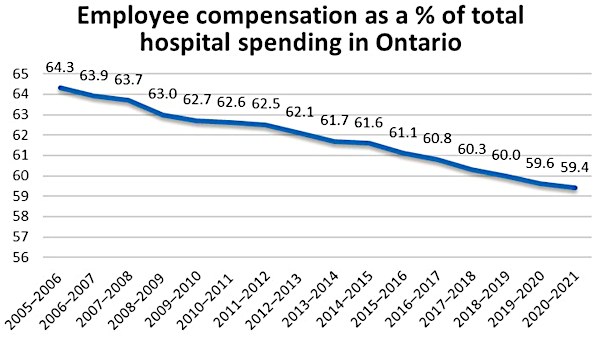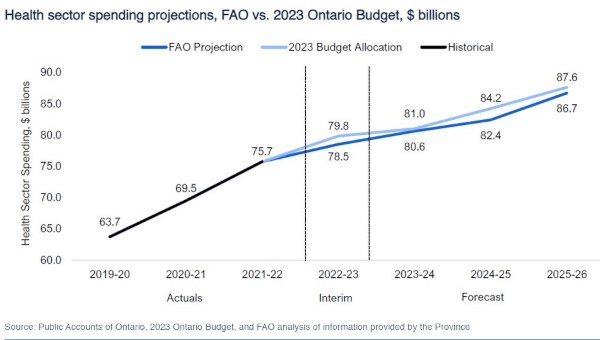Ontario Government: Hospital Workers Should Work Harder
With as much fanfare as it could muster, the Progressive Conservative government of Doug Ford re-announced its Budget plan of $300-million for hospitals to deal with the backlog of surgeries and procedures caused by the COVID-19 shut down of hospital services.
Despite the (attempted) fanfare, the Financial Accountability Office (FAO) has reported that the government’s budgeted plan for dealing with the backlog will fall hundreds of millions of dollars short of what is required to clear the COVID-19 backlog over three and a half years. The government says it is not working with the FAO estimates (indeed) and declined to make an estimate of how long it would take to deal with the backlog. The government did, however, state that it will “closely monitor” surgical outputs and wait times and will “implement additional measures if needed.”
The government claims the funding will enable hospitals to operate at 110-115% capacity. Operating room hours will be extended into the evening and weekends.

Extending Work Into Weekends
That’s a lot to ask hospital workers who are already burnt out after a year and a half of COVID.
“I just don’t see us running at 115 per cent with the resources that we have,” said Dr. Wassim Saad, Chief of Staff at Windsor Regional Hospital. “It’s just asking a little bit too much of people who have already given quite a bit during the pandemic.”
“To clear them (the backlogged patients) out with our current system I think is nearly impossible because I don’t think recruitment is going to happen any time soon, people need a break from this pandemic and there just isn’t the physical space and infrastructure to get them done in the time we’re being asked to do them,” said Dr. Saad.
Despite plans to run hospitals at 110% to 115% capacity, the hospitals are demanding concessions in provincial collective bargaining, and the government is sticking to its legislation that cuts real hospital worker wages by capping settlements at 1% (inflation is currently running at over 3%).
The government defends its odd way of thanking hospital workers by citing the “fiscal health” of the province. But it was recently revealed that last year’s deficit came in $9.2-billion less than planned, a figure that far surpasses any savings they might make by imposing 1% settlement caps. Indeed, as the FAO notes, government revenue forecasts suggest that tax cuts are coming – hardly a sign that they are truly worried about the fiscal health of the province.
Preparing for Tax Cuts
The government makes clear that not all hospitals will get in on the new funding – the Ministry of Health (along with Ontario Health) will identify which hospitals receive the money, with funding allocations planned for the fall (i.e., halfway through the fiscal year). The cash includes $18-million for “centralized surgical waitlist management,” $216-million for hospitals to extend operating room hours, $35-million for MRI and CT imaging, and $1-million for “surgical smoothing coaching” to support knowledge sharing and optimize the use of operating rooms at high-volume hospitals.
The government also largely confirms what was suspected by the FAO: that 3,100 recently created hospital beds are temporary, not permanent. If so, this means that even with the government’s plan to create an average of 324 new beds per year until 2029-30, we will still see a shrinkage in the overall number of hospital beds compared to what currently exists – right through the decade.
With no apparent shame at all, the government’s media release boldly claims they are increasing “overall” hospital funding $778-million this year. However, the government has actually budgeted $3.8-billion less for hospitals in 2021-22 (and even this includes a hoped-for increase of $1-billion via private payments to hospitals). “Discovering” this cut isn’t rocket science – it’s plainly stated in the Budget Estimates.
The government, it seems, is simply ignoring “COVID” hospital funding. They are sharply cutting this part of hospital funding – and, it seems, would rather not talk about it.
Despite the Ford government’s pretence, the reality is that hospitals will have to make do with billions less this year compared to last year – unless we force the government to change its plans.
The touching faith by our ruling elites that vaccination would put an end to COVID troubles was, shall we say, rather optimistic (like a lot of COVID planning in North America). A fourth wave is now a distinct possibility (if not here already, as is the case in the US and Britain). If so, even a government with the coldest heart will have a hard time resisting calls to stop the hospital funding cuts: bed cuts will be a disaster and closed hospital COVID testing centres will have to be re-opened and re-staffed.
Privatization Snuck In
In the same announcement, the Ford PC government also announced that it will increase funding for “Independent Health Facilities” (IHFs) by $24-million. Handing public cash over to their business pals is not a surprising move for the Ford government, but the size of this hand-out is still quite shocking. This is an incredible 48% in-year increase in funding for these private clinics that are almost always for-profit businesses. Some of the money will be used to create more IHFs. This will privatize a portion of public hospital services. Unlike hospitals, individual IHF facilities are unorganized, and are difficult to unionize due to their small size and for-profit ownership.
There has been a troubled history in Ontario of private clinics: safety problems, widespread extra-billing of patients, refusal to follow government orders, almost unlimited billing of the Ontario government, and continual problems of poor government oversight. The government’s release makes no mention of these problems, much less any steps to correct them now. •
This article first published on the Defend Public Healthcare website.





